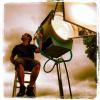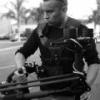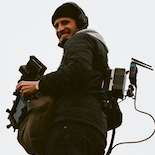-
Posts
325 -
Joined
-
Last visited
About Matthew Parnell
- Birthday 05/19/1988
Profile Information
-
Occupation
Gaffer
-
Location
Brisbane/Gold Coast/Sydney, Australia
Contact Methods
-
Website URL
http://www.mirrorfilmlighting.com
Recent Profile Visitors
-
For shooting at 24fps in 50hz countries you should be using a 172.8 Degree or 1/50th shutter. This will sort out most fixtures tied to mains frequencies- small tungsten, metal halides and fluorescents. Modern film fixtures- Flicker Free HMI and LED will be fine as usual. As far as practicals go, with the transition to LED it’s effectively the same as everywhere else with a hodge-podge of fitting, and the odd ones that will be problematic.
-
What grip lighting gear will you have? Achieving the looks of your reference material, especially on the budget you have, you will find your grip gear is going to be way more important than the lamps you have.
-

What is the purpose of a 9k hmi or equivalent?
Matthew Parnell replied to Edith blazek's topic in Lighting for Film & Video
As well as output level, you also have to take into account light quality when choosing a lamp. An 18k Frez has a much cleaner beam, and a much more even spread than the brutality that is the ‘M’ Series. Which makes it much more suitable as a hard light, especially in situations when you want clean shadow lines. It’s important to remember one of the core functions of location lighting is to create consistency. Sometimes you are shooting a 3-4 minute scene over several days. So to keep the look consistent, not only are you dealing with the changes of sun with the time of day, but you are also battling the variability of the weather over those days. This is where big units, big frames and machinery come in really handy. The DS lamps in terms of the world of LEDs are pretty old technology now, and being the first of their kind are a bit unrefined. I must admit I’ve been really underwhelmed by them and their system. I find the optics, and colour science to be perfectly usable, but problematic. In my experience they aren’t particularly user friendly, and their ergonomics when you start moving to the larger arrays is pretty poor (the DS3 Beam you are talking about is both heavy and rather awkward). Regardless, they do have a number of big advantages in having the ability to control them in terms of colour and dimming, but that does come at a cost, and to be honest the only time I would consider supplementing a HMI on location for a DS Array would be if I absolutely needed those features. -

What is the purpose of a 9k hmi or equivalent?
Matthew Parnell replied to Edith blazek's topic in Lighting for Film & Video
The M90 is a great tool, particularly for small to mid size work, and the reason why is almost about everything else than the lamp itself. With half the draw of an 18k, a M90 requires substantially less power infrastructure, this is particularly true in countries that operate on 240v power. In Australia, we commonly run 50 Amp 3 phase distribution on set, so an M90 with a real world draw of about 43-44 amps means we can run one with our existing standard power distribution and minimal additional work. The size of an M90 is a big factor- you can set it up, move it, and wrap it much quicker, and with a smaller crew, and it takes up less room in the truck. All those pros, and in the real world, output wise it is only about 1/2 stop less than a 18k Frez. -
The Cinescreen is significantly more dense at 2 stops compared to what looks like maybe around the 1/2 stop mark. The cinescreen is also much more forgiving in terms of moire than layering enough flyscreen to achieve the same. The cinescreen is also really durable- allowing for lots of re-use. Cinescreen is one of my favorite products in situations where you don’t need the optical clarity.
-

2,5kw HMI not starting *with video*
Matthew Parnell replied to Pieter Vanbrabant's topic in Lighting for Film & Video
That’s a send it in for repair problem by the looks. The ballast is probably 15-20 odd years old, the head even older. great gear, but just time for some TLC. -

dupixent commercials
Matthew Parnell replied to Michael Leake's topic in In Production / Behind the Scenes
I worked on this one as a lamp op. It was broken down into bite size pieces and shot over a couple days, if you look really closely you can notice the change of sun angles between the elements. They stitched it back together mainly using physical wipes in frame- extra crosses, lamp posts, trees etc as cutting points. -

WTB: Color Meter Sekonic / Kenko / Minolta
Matthew Parnell replied to Montell Taraschewski's topic in Cine Marketplace
Older style meters use 3 sensors with Red, Green and Blue filters, then derive a reading from the balance of those. The newer style spectrometers like the C700 and C800 use a CMOS to measure the spectral distribution of the light, and then can derive not just colour temperature, but a whole league of other readings. The older style meters are awesome with lights with a continuous or near-continuous spectrum- tungsten, hmi, most fluros etc. But the combination of how the older style meters actually measure light, along with the discontinuous spectrum of LED fixtures means accuracy and consistency goes out the window. A Titan tube, a Skypanel, a Kino Freestyle, and a Vortex all have incredibly different approaches to colour science in order to produce white light, resulting in vastly different spectral distribution curves to achieve the same colour temperatures- which inevitably means inaccurate readings on a CM3 or 3100. Additionally Commercial and residential grade LEDs also have a tendency to have large gaps in their spectrum, which can see you have what appears to be great readings on your 3100, but in reality is deficient in output at certain wavelengths, so you will struggle to get nice skin tones, or accurate colours. -

WTB: Color Meter Sekonic / Kenko / Minolta
Matthew Parnell replied to Montell Taraschewski's topic in Cine Marketplace
Could I ask why you want an older meter? I can only envisage you wanting to just use them on traditional hmi/tungsten fixtures. To be put frankly, these older meters are next to useless on modern LED fixtures- particularly fixtures using multi-colour arrays like skypanels, etc. -

48/96 Channel Light Board
Matthew Parnell replied to Amber Rout's topic in Lighting for Film & Video
The old style two preset 48/96 channel boards are pretty irrelevant as LED fixtures become more and more complex, and use more and more channels. I own a handful of these desks, and they have all been gathering dust for the last few years. The preset desks, while they will work, just aren’t particularly suitable. Even on smaller jobs that may have previously been 36-48 channels you can now easily be needing 1-2 universes to control (1 universe = 512 channels) a set. I would consider checking out Luminair or even better Blackout- it’s a great lighting console app for iPads designed for film and tv. It’s a really good ‘small-mid scale’ solution. -
I’ve got one. They’re a nice little unit. Nice and versatile. Can be used as an AKS. As an expansion to an AKS for additional universes, as an extra transmitter in a larger network. The web app works well for configuration. Would love a bit more battery life, but nothing a battery bank can’t fix.
-

Wanting to buy my first light meter
Matthew Parnell replied to Hendrikus De Vaan's topic in General Discussion
I did a meter update last year and got a Sekonic L858 and C800. Im really enjoying both of them. You can’t ask for much more from an exposure meter than what the L858 delivers. The touch screen takes a little getting used to, especially coming from older meters, but once you do get used to it and set it up for how you want to work you struggle going back. The build quality is really nice, the only thing I don’t particularly like is sekonic’s horizontal position meter pouches. -

Header cable repair Hmi plugs
Matthew Parnell replied to Niall Flynn's topic in Lighting for Film & Video
We’ve found it’s often more cost effective to purchase new header cables. The Veam connectors are notoriously expensive on their own, and need special tooling and an experience hand to get right. Strand 2.5 and 1.2 connectors are similar but have different keyways. This is by design because mismatching the ballast and head can be catastrophic to both. -

Led fixtures with adjustable HSI base kelvin
Matthew Parnell replied to Jonathan O'Neill's topic in Lighting for Film & Video
Kino Celebs and the Litemat Spectrums do natively. Skypanels and Vortex8’s allow you to do this via DMX by using the cross fade channel. Set the saturation to 100% and use the cross fade channel as your saturation.








